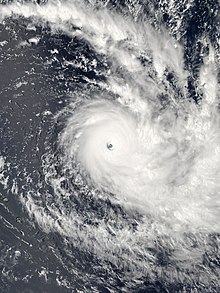 Cyclone Yasa at peak intensity on December 16 | |
| Meteorological history | |
|---|---|
| Formed | December 11, 2020 |
| Extratropical | December 19, 2020 |
| Dissipated | December 24, 2020 |
| Category 5 severe tropical cyclone | |
| 10-minute sustained (FMS) | |
| Highest winds | 230 km/h (145 mph) |
| Lowest pressure | 917 hPa (mbar); 27.08 inHg |
| Category 5-equivalent tropical cyclone | |
| 1-minute sustained (SSHWS/JTWC) | |
| Highest winds | 260 km/h (160 mph) |
| Lowest pressure | 914 hPa (mbar); 26.99 inHg |
| Overall effects | |
| Fatalities | 4 total, 1 missing |
| Damage | >$247 million (2020 USD) |
| Areas affected | Vanuatu, Fiji, Tonga |
| IBTrACS | |
Part of the 2020–21 South Pacific cyclone season | |
Severe Tropical Cyclone Yasa was the second Category 5 severe tropical cyclone in 2020 after Harold in the 2019–20 South Pacific cyclone season. Yasa was the second tropical disturbance, as well as the first tropical cyclone and severe tropical cyclone of the 2020–21 South Pacific cyclone season. Yasa was first noted as an area of low pressure to the north of Port Vila in Vanuatu during December 10. Over the next few days, the system gradually developed further as it absorbed Tropical Depression 01F, before it was classified as a tropical cyclone and named Yasa by the Fiji Meteorological Service on December 13.
The system gradually moved through the South Pacific Ocean, going through a small, slow loop whilst rapidly intensifying. In about a day, it became a Category 5 severe tropical cyclone on the Australian scale and a few hours later, a Category 5-equivalent cyclone on the Saffir-Simpson scale, with 1-minute sustained winds of 260 km/h (160 mph) and a minimum pressure of 917 hPa (27.1 inHg). This made Yasa the earliest Category 5 tropical cyclone on both the Australian and Saffir-Simpson scales in the South Pacific basin since reliable records began, beating the old record by Cyclone Zoe in 2002–03.
Yasa maintained its intensity and became more defined on satellite imagery as it bore down on Fiji. An address was sent to the entire country from the nation's Prime Minister Frank Bainimarama regarding preparations for the storm. Shipping services were halted, and fishermen were advised to not go out into sea, due to fears of Yasa possibly injuring or killing them. Multiple warnings were issued, including heavy rain, heavy wind, and flood warnings. Soon, the entirety of Fiji was under warnings as Yasa neared. A high wind warning was put in place for Vanuatu as the storm's wind field reached the country. Impacts began to be felt on mid-day December 16, as villages in the Malolo and Yasawa groups began to feel the winds and rain of Yasa. The impacts felt from Yasa were large and wide. As of December 22, impacted areas are beginning to restore communication. Transportation was hampered as 72 roads in the country were closed due to fallen trees, power lines, and flooding. Heavy rain was recorded in most of the country. Four deaths were confirmed, while one person remains missing.[1] Damage estimates in Fiji were calculated at a minimum total of FJ$500 million, or US$246.7 million (2020 USD).[2]
Many affected people had their access to food and water cut off following Yasa's passage through Fiji. The International Federation of Red Cross and Red Crescent Societies provided funding and relief items to about 17,700 Fijians by December 18, and provided the Fijian Ministry of Health and Medical Services with supplies. Australia pledged its assistance and sent HMAS Adelaide to help with recovery efforts.
- ^ "TC Yasa claims four lives". Fiji Broadcasting Corporation. Retrieved December 18, 2020.
- ^ "Cyclone Yasa Damage Costs Hit $500m: Seruiratu". Archived from the original on February 13, 2021. Retrieved February 14, 2021.